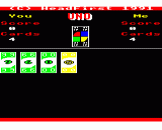
(C) 1984 International Games Ltd., 1989 Waddingtons Games Ltd
Program (C) 1991 HeadFirst PD
Game Objective
The object of the game is to score 500 points before the computer. Points are scored by ridding yourself of all your cards before the computer.
Summary Of Play
 The computer will deal seven cards to each player, the remaining cards are kept as a drawpile by the computer. The top card of this pile is shown face up, as the top card of a new discard pile.
The computer will deal seven cards to each player, the remaining cards are kept as a drawpile by the computer. The top card of this pile is shown face up, as the top card of a new discard pile.
The first player chooses a card from his/her hand by matching colour or type of the top card of the discard pile. This then is placed as the top card of the discard pile for the next player to match. A Wild card will always fit. If at any time a player cannot play any of his cards, he must draw one from the drawpile, which he may then play, and then turn passes to the next player.
Special cards add interest and depth to the game by causing the other player to draw extra cards, or to miss a go.
The cards are marked very clearly and are instantly understandable. For this reason it takes only a few games to become almost an expert player. As you learn to play and to use the strategies possible, you will find the game very stimulating and exciting.
The pack contains 108 cards as follows:
| 2 | * | each number 1-9 in each of four colours (red, green, yellow, blue) |
| 1 | * | number 0 in each of four colours |
| 2 | * | Draw Two cards in each of four colours |
| 4 | * | Skip cards in each of four colours |
| 4 | * | Wild cards |
| 4 | * | Wild Draw Four cards |
Deal
The computer begins play by shuffling the pack and dealing seven cards to the player and seven to itself. The remaining cards are kept by the computer for use as a drawpile, with the exception of the top card which is shown on the screen and forms the discard pile.
The computer randomly decides who will start the first hand of the game, subsequent hands are started in alternate order. The starting player must choose a card from their hand that matches either the colour or number of the top card of the discard pile.
If for example a green six is turned up after the deal, the starting player may play any green card he/she has, or any number six card of another colour.
If the first card turned up is a "special" card, play begins as follows:
Wild card - the starting player chooses colour and then plays.
Draw Two card - the starting player gets two extra cards and the other player begins play.
Skip card - the other person starts play.
Play
Play continues with each player either matching colour or type of the top card of the discard pile or by following directions of a special card. If you are unable to match a card or play a wild card, you must draw a card from the drawpile. If the drawn card is playable, you may play it immediately otherwise play passes to the computer.
When it is your turn, the computer will sound a short pip. To choose the card to play, move the flashing white arrow around using the arrow keys on the computer. Press RETURN to select a card. If you must pick up a card, press P. Now you may again press RETURN to play that card or P to pass the turn to the computer. NB The computer will check that your choice is playable before playing it; it will not allow you to play incorrect moves (with the exception of Wild Draw Four cards, see Penalties).
The computer will take care of its own turn, and also of any cards given to you due to it playing Draw Two or Wild Draw Four cards. It will also keep a track of how many cards each player has in their hand and display this at the top of screen on either side of the discard pile. When it chooses colour it will inform you of the colour it has chosen using the message bar at the bottom of the screen.
Special Cards
Draw Two - When a Draw Two is played, the next player is given two extra cards and play passes back to the person who placed the Draw Two.
Skip - The next player misses his/her turn and play passes back to the person who paced the Skip card.
In this way a player can put down many cards in succession without the other player having a turn, by carefully playing their special cards by matching type or colour.
Wild Cards
Wild cards may be played on any colour or type of card. The player playing a Wild card has the advantage of choosing the colour in which play will continue. This colour can be the same as the colour already in play. The playing of a Wild card has no effect on the next player other than altering colour and it may be played even when the player holds other playable cards in their hand. There is no restriction on the playing of Wild cards. NB You choose colour by typing the first letter of the colour (R, G, Y or B).
Wild Draw Four Cards
The playing of this card not only allows the player to choose colour as in the Wild card, but also causes the next player to take four more cards and play returns to the player of the Wild Draw Four card. This card may only be used when a player does not have a card in his hand matching the colour currently in use. A player may have a card matching type of the current card and still play his Wild Draw Four card. For example, if the top card of the discard pile is a Blue Two, and the player has a Green Two and a Wild Draw Four card, he may play the Wild Draw Four card. If, however, he has a Blue Six as well, he may not. The computer will not prevent you trying to play a Wild Draw Four incorrectly, but you will incur a penalty for doing so (see Penalties).
Going Out
When a player plays their last card, thus ridding their hand of all cards, the hand is over. Points are scored, the cards are collected, reshuffled and a new hand is dealt with the other player starting. The computer will add up the scores and display them on the screen; if you won, it will show you the cards left in its hand. If the last card played is a Draw Two or Wild Draw Four card, these cards are added to the losing player's hand before the points are counted.
Counting And Scoring
The values of the cards are as follows:
| All cards 0-9 | Face Value |
| Draw Two Cards | 20 |
| Skip Cards | 20 |
| Wild Cards | 50 |
| Wild Draw Four Cards | 50 |
The amount of points scored by the winner of each hand is equal to the value of cards in the losing player's hand. These points are added to the winning player's score. The first player to reach 500 points is the winner.
Penalties
If a player plays a Wild Draw Four card when he/she has a playable colour in his hand, they are penalised and must draw four cards. They also must keep their Wild Draw Four card and lose their turn.
Reneging
On any turn you may choose not to play a card. If so, you must draw a card just the same as if you had no play to make (by pressing P). If the card drawn is playable, you may play that card but may not play a card already in your hand. Only the card drawn may be played.
The Strategy of Reneging
E.g. The computer has played its second to last card. It was a Wild card and it chose red. Most likely its last card is red. You have a red card in your hand but you want to change the colour so the computer can not go out. You choose to draw a card by pressing P hoping that you will get a Wild card to prevent it from going out.
Rules To Remember
- Wild cards can be played at any time during the game.
- Wild Draw Four cards can only be played if you do not have a playable colour in your hand.
- Draw Two, Draw Four, or Skip cards cannot be cancelled out by the playing of a matching card by the other player. The special cards' directions are always followed even if a draw card is the last card played in a game.
- You can match colour on colour or type on type.
- When a Wild card or Wild Draw Four card is played you may call any colour you wish. This may be the colour already being played or a colour you do not have in your hand.
- When reneging you may play the card drawn from the drawpile but you may not play a card from your hand after a draw.
Note: You will not see the loading screen if playing this game on a memory-restrained system.
